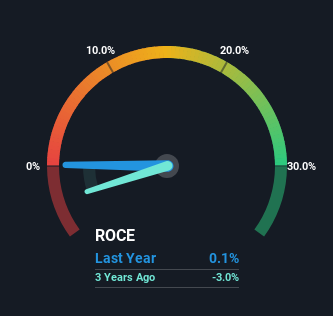- Hong Kong
- /
- Healthcare Services
- /
- SEHK:401
Wanjia Group Holdings (HKG:401) Will Be Looking To Turn Around Its Returns

What financial metrics can indicate to us that a company is maturing or even in decline? When we see a declining return on capital employed (ROCE) in conjunction with a declining base of capital employed, that's often how a mature business shows signs of aging. This indicates to us that the business is not only shrinking the size of its net assets, but its returns are falling as well. Having said that, after a brief look, Wanjia Group Holdings (HKG:401) we aren't filled with optimism, but let's investigate further.
What Is Return On Capital Employed (ROCE)?
For those that aren't sure what ROCE is, it measures the amount of pre-tax profits a company can generate from the capital employed in its business. To calculate this metric for Wanjia Group Holdings, this is the formula:
Return on Capital Employed = Earnings Before Interest and Tax (EBIT) ÷ (Total Assets - Current Liabilities)
0.001 = HK$137k ÷ (HK$173m - HK$38m) (Based on the trailing twelve months to March 2023).
Therefore, Wanjia Group Holdings has an ROCE of 0.1%. In absolute terms, that's a low return and it also under-performs the Healthcare industry average of 11%.
See our latest analysis for Wanjia Group Holdings

Historical performance is a great place to start when researching a stock so above you can see the gauge for Wanjia Group Holdings' ROCE against it's prior returns. If you'd like to look at how Wanjia Group Holdings has performed in the past in other metrics, you can view this free graph of past earnings, revenue and cash flow.
The Trend Of ROCE
The trend of returns that Wanjia Group Holdings is generating are raising some concerns. To be more specific, today's ROCE was 0.4% five years ago but has since fallen to 0.1%. What's equally concerning is that the amount of capital deployed in the business has shrunk by 37% over that same period. When you see both ROCE and capital employed diminishing, it can often be a sign of a mature and shrinking business that might be in structural decline. If these underlying trends continue, we wouldn't be too optimistic going forward.
On a side note, Wanjia Group Holdings has done well to pay down its current liabilities to 22% of total assets. So we could link some of this to the decrease in ROCE. What's more, this can reduce some aspects of risk to the business because now the company's suppliers or short-term creditors are funding less of its operations. Some would claim this reduces the business' efficiency at generating ROCE since it is now funding more of the operations with its own money.
The Bottom Line On Wanjia Group Holdings' ROCE
In short, lower returns and decreasing amounts capital employed in the business doesn't fill us with confidence. We expect this has contributed to the stock plummeting 83% during the last five years. Unless there is a shift to a more positive trajectory in these metrics, we would look elsewhere.
Since virtually every company faces some risks, it's worth knowing what they are, and we've spotted 3 warning signs for Wanjia Group Holdings (of which 1 is potentially serious!) that you should know about.
If you want to search for solid companies with great earnings, check out this free list of companies with good balance sheets and impressive returns on equity.
If you're looking to trade Wanjia Group Holdings, open an account with the lowest-cost platform trusted by professionals, Interactive Brokers.
With clients in over 200 countries and territories, and access to 160 markets, IBKR lets you trade stocks, options, futures, forex, bonds and funds from a single integrated account.
Enjoy no hidden fees, no account minimums, and FX conversion rates as low as 0.03%, far better than what most brokers offer.
Sponsored ContentValuation is complex, but we're here to simplify it.
Discover if Wanjia Group Holdings might be undervalued or overvalued with our detailed analysis, featuring fair value estimates, potential risks, dividends, insider trades, and its financial condition.
Access Free AnalysisHave feedback on this article? Concerned about the content? Get in touch with us directly. Alternatively, email editorial-team (at) simplywallst.com.
This article by Simply Wall St is general in nature. We provide commentary based on historical data and analyst forecasts only using an unbiased methodology and our articles are not intended to be financial advice. It does not constitute a recommendation to buy or sell any stock, and does not take account of your objectives, or your financial situation. We aim to bring you long-term focused analysis driven by fundamental data. Note that our analysis may not factor in the latest price-sensitive company announcements or qualitative material. Simply Wall St has no position in any stocks mentioned.
About SEHK:401
Wanjia Group Holdings
An investment holding company, engages in pharmaceutical wholesale and distribution business in the Mainland China and Hong Kong.
Flawless balance sheet low.
Market Insights
Community Narratives



